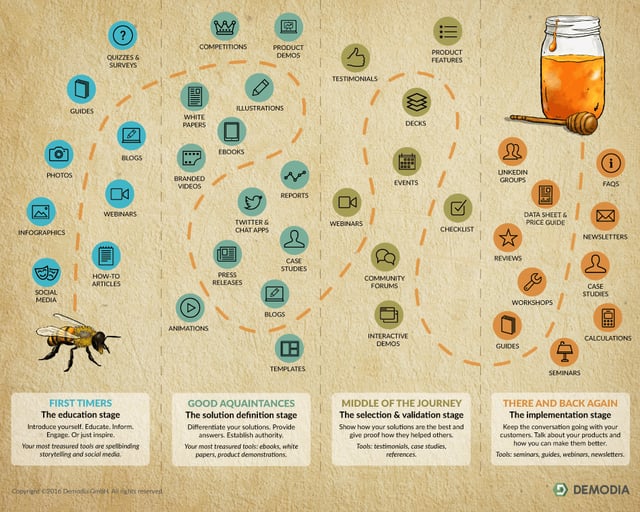
Does your business have a digital marketing strategy?
Your first instinct might be to answer “well, sure we do!” Chances are, you’re online and your marketing is too. You might think that your online marketing campaigns equal a digital marketing strategy, but that’s not really the case. Your campaigns are tactics, stepping stones towards reaching your goal. But what is your goal? And how does each marketing action you take contribute to that goal? These are the questions that a true strategy must answer.
Without a digital marketing strategy, you’ll never be truly optimizing your integrated marketing efforts. You need a strategy Crafting a strategy requires some big-picture thinking, to bring all your hard work together under one vision for the future of your business.
In the simplest terms, your strategy should be an overarching, measureable goal that informs all your marketing campaigns and efforts. Here are our five steps to create a digital marketing strategy that will launch your business to the next level.
1. Assess where you are.
When you’re crafting your goal, you’ll need to properly assess the current state of your business in order to improve. Look at your past and current marketing campaigns: what worked? What didn’t work? Measure the pay-off of your current marketing, because your marketing strategy will generally entail improving your ROI. Examining the effectiveness of your current marketing will help you set your goal. A good goal format to start with often follows the model of “improve ‘X’ by ‘Y’% in ‘Z’ period of time.
Next, look at your business’s resources. Can you realistically meet your goal with your current team, or should you look into outsourcing or hiring more help? Be sure to seek input from your employees or partners at this stage. What’s your budget for digital marketing, and is it enough to reach your goal? Often, seeking outside help for your marketing strategy can be a better value than taking on new hires internally.
2. Reach for the moon with a bold goal.
Once you’ve assessed your current situation, it’s goal-setting time. For a marketing strategy, it’s okay (encouraged, in fact!) to think big. Maybe you want to improve your marketing ROI by a certain percentage within the next year, maybe you want to grow your client base to a certain size. Your goal can be a bit broad– for example, to position your business as the local or regional leader in your industry– as long as you can reliably measure your progress to see that you’re on track.
Choose your goal carefully, because this is the backbone of your digital marketing strategy. Once you have a goal, you should consider all your future marketing actions based on how they advance that goal. This goal is what brings together many divergent marketing campaigns and tactics, into a true strategy.
3. Take stock of what you already have.
In addition to your human resources, assess your current arsenal of marketing assets. This assessment includes your original content, your earned and paid-for audiences on social media, and all your available media channels. It’s a good idea to keep a spreadsheet of all these assets. The idea is to see how they work in unison, so you can further integrate all your marketing efforts to feed and boost one another.
You might realize that you need to update or improve some of your owned assets, and you might also notice that some assets aren’t serving you at all. A periodic audit of the marketing assets you already have will enable you to see where your efforts are getting the most return, and how you can use what you already have to best effect.
4. Get to know your market.
If you don’t have a buyer persona yet, now’s the time to make one. If you do, it’s a good time to review it and see if it needs improvement.
Your buyer persona is an integral part of your digital marketing strategy, because these are the people you’re trying to reach. Aside from their interest in your product, a buyer persona should cover as many aspects of your potential clients as possible: their hobbies, concerns, needs. Most importantly, you need to know where your buyer persona is spending their time online.
As part of your strategy, every time you implement a new marketing action, you should ask yourself, “will this reach my buyer persona?” Once you’ve nailed down your buyer persona, take time to create a great value proposition that will grab their attention.
5. Make a plan, and make it happen!
Now that you have a true digital marketing strategy, you can plan and implement your marketing campaigns accordingly. Bring together all your careful research about your marketing assets and your buyer persona, and keep the focus on your goal.
The planning process is ongoing, and– unlike your marketing strategy– you can change your plans when you need to. Keep assessing your progress as you go, so you can adjust your tactics as you learn what works and what doesn’t.
Now that you’ve got the ball rolling, follow the marketing strategy life-cycle: Goal, strategy, action. You can also follow this life-cycle as you implement campaigns and actions within your strategy, by setting a mini-goal for the campaign, strategizing, and then putting your plan into action.
If you need help creating a digital marketing strategy, Demodia is here for you. Whether your business specializes in B2B or B2C services, we’re always ready to share our expertise to help you see growth and success. Contact us and ask us anything to get the conversation started!


